Samsung Galaxy S 6 and S 6 Edge: Preview
by Joshua Ho on March 26, 2015 9:00 AM EST- Posted in
- Smartphones
- Samsung
- Mobile
- Galaxy S6
- Galaxy S6 Edge
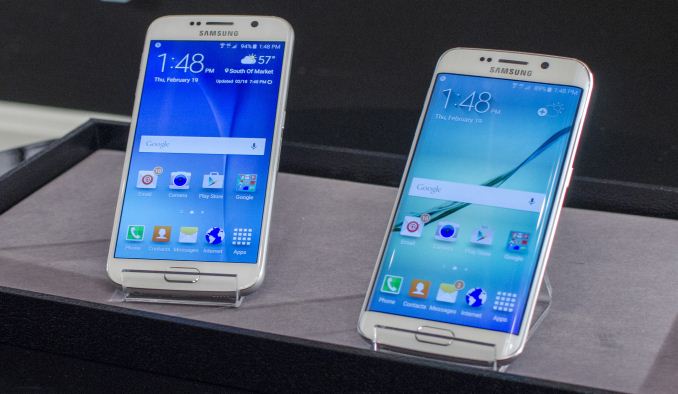
Yesterday we received our Galaxy S6 and S6 edge review units. We’re still working on the final review but I wanted to share some early results from both devices. For those that are unfamiliar with these two phones, the Galaxy S6 range represents the result of Samsung’s “Project Zero”. In fact, the phones seem to have the internal name of Zero, which can be seen in terminal, and the build properties of both devices. For Samsung, these phones represent their attempt at completely rethinking how Samsung makes phones. There is a strong emphasis on a new unibody design, which has no visible gaps or screws. Rather than the plastic that previous Samsung phones have been known for, the new design is composed of metal and glass. Samsung’s design team has been given unprecedented control throughout the process of making this phone and the result of this is a Galaxy phone that looks unlike anything else they’ve ever released.
Even if design is important, it isn’t enough to make the phone. Samsung has also outfitted the Galaxy S6 and S6 edge with their latest technologies, from a new AMOLED display to a new camera module. The specs for both phones can be seen below.
| Samsung Galaxy S5 | Samsung Galaxy S6 | Samsung Galaxy S6 Edge | |
| SoC | MSM8974ACv3 2.45 GHz Snapdragon 801 | Exynos 7420 2.1/1.5GHz A57/A53 | Exynos 7420 2.1/1.5GHz A57/A53 |
| RAM/NAND | 2GB LPDDR3 16/32GB NAND + microSD |
3GB LPDDR4-1552 32/64/128GB NAND |
3GB LPDDR4-1552 32/64/128GB NAND |
| Display | 5.1” 1080p SAMOLED HD |
5.1” 1440p SAMOLED |
5.1” 1440p SAMOLED, Dual Edge |
| Network | 2G / 3G / 4G LTE (Qualcomm MDM9x25 UE Category 4 LTE) | 2G / 3G / 4G LTE (Category 6 LTE) | 2G / 3G / 4G LTE (Category 6 LTE) |
| Dimensions | 142 x 72.5 x 8.1 mm, 145 grams | 143.4 x 70.5 x 6.8mm max, 138 grams | 142.1 x 70.1 x 7.0mm max, 132 grams |
| Camera | 16MP (5132 x 2988) Rear Facing with 1.12 µm pixels, 1/2.6" CMOS size, 31 mm (35mm effective), f/2.2 | 16MP (5132 x 2988) Rear Facing w/ OIS, f/1.9, object tracking AF | 16MP (5132 x 2988) Rear Facing w/ OIS, f/1.9, object tracking AF |
| 2MP Front Facing | 5MP Front Facing, f/1.9 | 5MP Front Facing, f/1.9 | |
| Battery | 2800 mAh (10.78 Whr) | 2550 mAh (9.81 Whr) | 2600 mAh (10.01 Whr) |
| OS | Android 4.4 w/TouchWiz |
Android 5 (64-bit) w/TouchWiz | Android 5 (64-bit) w/TouchWiz |
| Connectivity | 802.11a/b/g/n/ac 2x2 + BT 4.0 (BCM4354), USB3.0, GPS/GNSS, MHL, DLNA, NFC |
2x2 802.11a/b/g/n/ac + BT 4.1 (BCM4358), USB2.0, GPS/GNSS, NFC |
2x2 802.11a/b/g/n/ac + BT 4.1 (BCM4358), USB2.0, GPS/GNSS, NFC |
| Wireless Charging | N/A | WPC 1.1 (4.6W) & PMA 1.0 (4.2W) |
WPC 1.1 (4.6W) & PMA 1.0 (4.2W) |
| Fingerprint Sensor | Swipe | Touch | Touch |
| SIM Size | MicroSIM | NanoSIM | NanoSIM |
Both the Galaxy S6 and S6 edge have Samsung System LSI’s newest SoC, the Exynos 7420, which has a cluster of four Cortex A57s clocked at 2.1 GHz, and four Cortex A53s clocked at 1.5 GHz. Compared to the Exynos 5433 of the Galaxy Note 4, this brings a new 14nm LPE (low power early) process, an upgrade to LPDDR4 memory, and a Mali T760 GPU with two additional shader cores. Outside of the SoC, the new display is advertised to bring a higher 600-nit brightness and a higher 1440p resolution. The front and rear cameras are both different from the Galaxy S5 as well, although the rear camera sensor may be shared between the two as the camera sensors are of similar spec. For this preview, we’ll focus on the system performance and display of these new devices, but as one can see from the specification table there is far more to look at for the full review.
System Performance
For our system performance benchmarks we’ll start with our browser tests which can give a rough proxy for overall CPU performance.
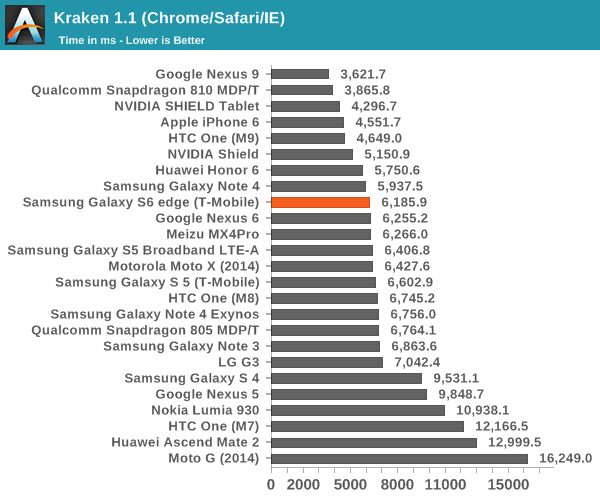
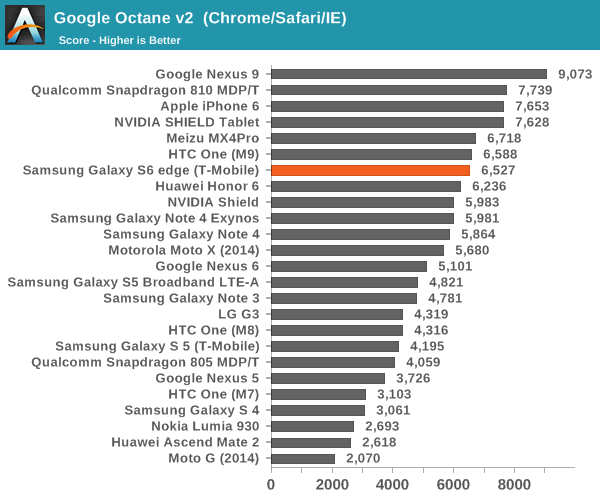
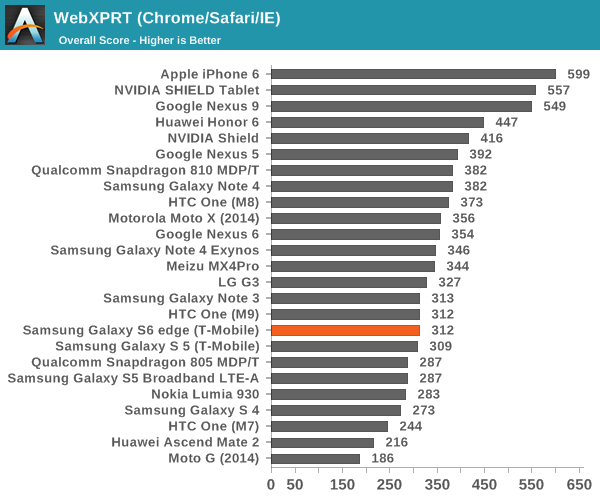
The Exynos 7420 is about on par with the Snapdragon 810 in these benchmarks. Strangely enough both tend to do worse than the Huawei Honor 6 in these tests, which clearly can't be correct. As we've previously discussed, the stock browser will often give far better results due to OEM and SoC vendor optimizations. As a part of our updates to the benchmark suite for 2015, we'll take a look at Basemark OS II 2.0, which should give a better picture of CPU performance in addition to overall device performance.
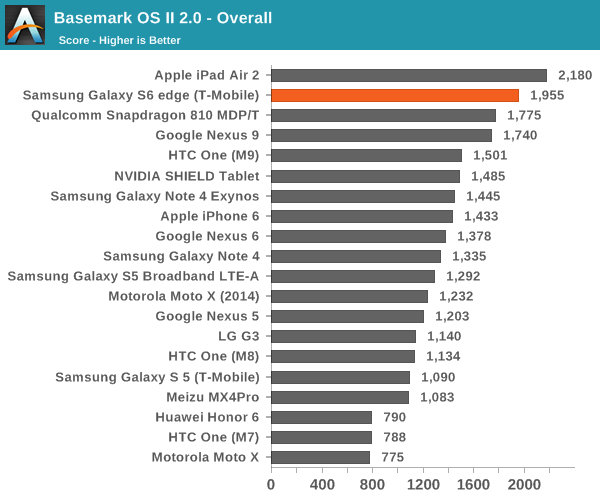
The browser benchmarks seem to hide some pretty enormous variability as the Galaxy S 6 edge (which is comparable to the Galaxy S 6) sets a new record among Android devices. The only challenger is the iPad Air 2, which uses the A8X SoC with three Enhanced Cyclone cores and the semi-custom GXA6850 GPU.
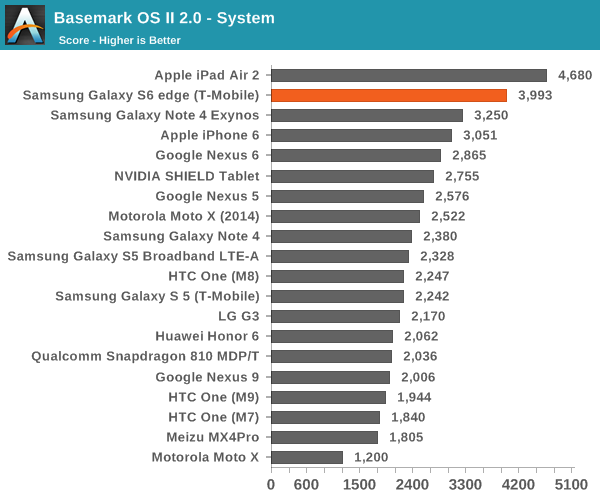
This system test contains a floating point and integer test, in addition XML parsing, which means that this test mostly stresses CPU and RAM. Interestingly enough, the Exynos 7420 pulls far ahead of both the Exynos 5433 and Snapdragon 810 in this test, and approaches the A8X. The difference between the 5433 and 7420 is likely a combination of the higher clocks on both the A57 and A53 clusters for the 7420 (1.9/1.3 on the 5433, 2.1/1.5 on the 7420), in addition to the ability to stay at a high 'overdrive' clock due to reduced leakage from the 14LPE process. The One M9 likely falls a bit short here due to HTC's governor settings restricting the use of all 8 cores simultaneously.
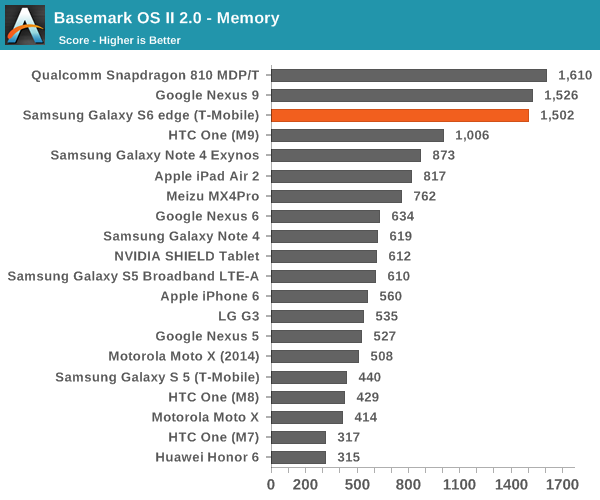
While one might guess that the memory test of 'Basemark OS II 2.0 - Memory' is of RAM, this is actually a test of the internal storage. Once again we see the S6 edge come close to leading the pack due to the use of the new UFS (Universal Flash Storage) standard. Casual examination reveals that the S6 edge has a queue depth of 16, and that it identifies itself with the rather cryptic model name of KLUBG4G1BD-E0B1.
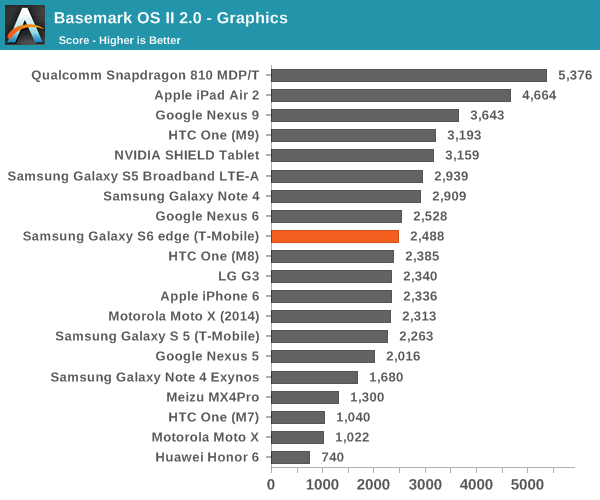
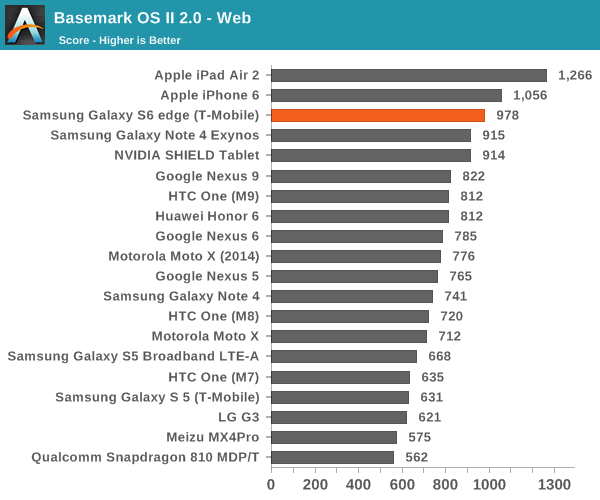
For the web test, it uses the built-in WebView rendering engine rather than Chrome and paints a distinctly different picture, especially because these tests are focused on HTML5 and CSS rather than JavaScript. Here we can see that the iPhone 6 and iPad Air 2 continue to hold their lead, but the Galaxy S6 is pretty much the king of the hill when it comes to Android devices.










200 Comments
View All Comments
makxon - Friday, March 27, 2015 - link
Bullshit! lying troll bastard, 600 cycles is more like 3 years of use and typically only drop at 90%. even my sister's acer midrange phone from 2013 battery still work normaly no noticable battery drop and never once managed at service center.sonny73n - Friday, March 27, 2015 - link
Anandtech please ban this foul mouth (possible a Samsung fanboy/paid shill too)By the way, Li-ion battery has about 300 to 500 charge/discharge cycles. If you play graphic intense games like Need For Speed or CoD Zombies 3-4 hours a day like I do, the battery will only last for about a year. So when he said his battery died after a year and a half could be very possible.
Some people don't use their phones much. Others completely drain their batteries at least once a day, even leave phones in their cars in hot summer. More usage -> more charging + heat = shorten battery life. It's completely understandable.
Jedi2155 - Sunday, March 29, 2015 - link
600 cycles can be done easily in a year as sonny73n said. My Note 4 regularly goes through 2 cycles a day (streaming twitch at work) or playing games if you use your device intensively.600 cycles isn't so bad though if you keep in between 20-80% SOC as I do. Its only if you keep it close to 100% SOC that it really only last 300-500 cycles. If you keep it away from being fully charge it can last a very long time.
My Note 2 is still on its original battery with no perceptible loss of capacity even after 2.5 years. I probably put well over a 1000 cycles on it. Of course if I measured it I'd bet I loss no more than 20-30%.
Gigaplex - Friday, March 27, 2015 - link
My S4 battery needed replacing after 3 months of usage as it had short battery life, bulged a lot and got very warm. The S4 has a pretty bad reputation for a bad batch of batteries.josephnero - Friday, March 27, 2015 - link
Check Z3 and you will see how is that badFlunk - Thursday, March 26, 2015 - link
I'm sure you can still get a new battery, it just means that you'll need a technician to install it (assuming you can't do it yourself).III-V - Thursday, March 26, 2015 - link
I fix phones for a living, and I can say that pretty much all batteries are removable in phones. Most of them are fairly easy if you know what you're doing, although a heat gun can help, as long as you don't cook anything (which is really easy to do if you're inexperienced).I think I've only seen soldered connectors on tablets. However, there's a few dumb designs where you have to remove the LCD to get to the battery (which in most cases means you'll need to replace the LCD as well).
My concern is that if the S6 is built like the "water-resistant" S5 is, in that you cannot access the internal components (other than the battery) without taking off the LCD, then you're in for a very expensive battery replacement. Samsung likes to adhere their LCDs like crazy, and they're very difficult to remove without damaging them. They're also 2-3x the price of everyone else's LCDs. You'd be looking at basically $200 to replace a battery yourself, and although that cost will probably come down to around $150 after things settle a bit, it's still not a pretty picture. Oh, and that's the cost to do it yourself. Most other phones have batteries available for $10-20.
III-V - Thursday, March 26, 2015 - link
Just checked a teardown -- it doesn't look like you have to go through the LCD to change the battery. You do need a hairdryer or heat gun, though.hrrmph - Friday, March 27, 2015 - link
It used to be with Samsung that you could "pop the back off and pop a new battery in."With this debacle of a phone, Samsung has just given away one of it's main distinguishing features. All to emulate Apple's "jewelry first, functionality later" approach.
We already have enough manufacturers making jewelry. The last thing we needed was to lose a good hardware feature oriented manufacturer like Samsung to the vagaries of fashion.
SirMaster - Thursday, March 26, 2015 - link
How are they screwed?According to this people with iPhones are screwed too. But it's not that hard to remove 3 screws to change out the battery...